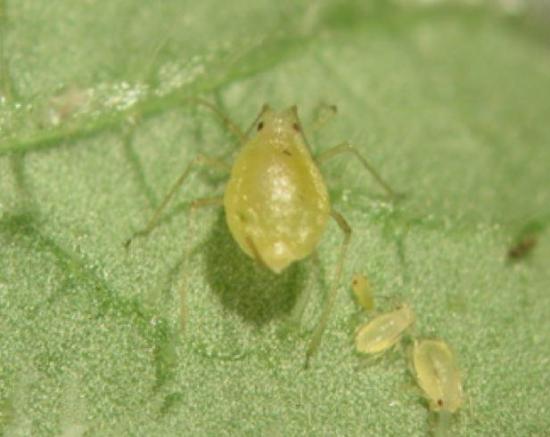加州大学的科学家在短短几代蚜虫中发现了快速的遗传变化可影响种群的数量和其它生物学方面。

雌性蚜虫和它的无性繁殖后代
这一研究提高了科学家对濒危物种、入侵物种和疾病疫情的预测能力,相关的研究发表在8月9日的Ecology Letters 期刊上。
蚜虫是世界上最重要的农作物害虫,研究人员在作物生长的季节测试快速的进化对这一野生种群的影响。为了达到这一目标,研究人员开展试验阻止一些蚜虫发生自然选择的进化,同时允许另一部分蚜虫在自然条件下进化。接着,他们比较了进化种群和非进化种群的增长速度。
每年秋季,蚜虫进行一代有性繁殖。次年秋季,它们进行多代无性繁殖。在这段时期内,多个无性种系相互竞争引起基因频率和种群特征值的改变。
在试验中,研究人员比较了2种无性蚜虫种群,一种是遗传物种相同的克隆体;另一种是遗传物质不同的克隆体。
随着种群的增长,研究人员测试了混合种群是否进化。通过对蚜虫的计数,他们发现在30天内(或4-5代中)克隆体的遗传频率快速变化。然后检测遗传频率的改变对蚜虫生态的影响,进化种群的增长速度比非进化种群的超出了42%。
这表明,没有人类干扰下自然选择能引起蚜虫种群快速进化,随着杀虫剂的使用,这一影响被认为更加强烈。几十年来,人们认为进化速度很慢,因此在研究种群增长时没有考虑这一因素。进化因素的忽略会引起过低地估计害虫的密度和暴发。
快速进化在其它方面具有未检测出的重要作用,例如,快速进化在渔业中很重要,因为过度的捕捞导致鱼类进化出逃避渔网的能力。此外,病原体的抗生素抗性和更强的毒性是一个关于快速进化影响人类健康的例子。(生物探索译 Pobee)
生物探索推荐英文摘要
The impact of rapid evolution on population dynamics in the wild: experimental test of eco-evolutionary dynamics
Rapid evolution challenges the assumption that evolution is too slow to impact short-term ecological dynamics. This insight motivates the study of 'Eco-Evolutionary Dynamics' or how evolution and ecological processes reciprocally interact on short time scales. We tested how rapid evolution impacts concurrent population dynamics using an aphid (Myzus persicae) and an undomesticated host (Hirschfeldia incana) in replicated wild populations. We manipulated evolvability by creating non-evolving (single clone) and potentially evolving (two-clone) aphid populations that contained genetic variation in intrinsic growth rate. We observed significant evolution in two-clone populations whether or not they were exposed to predators and competitors. Evolving populations grew up to 42% faster and attained up to 67% higher density, compared with non-evolving control populations but only in treatments exposed to competitors and predators. Increased density also correlates with relative fitness of competing clones suggesting a full eco-evolutionary dynamic cycle defined as reciprocal interactions between evolution and density.







